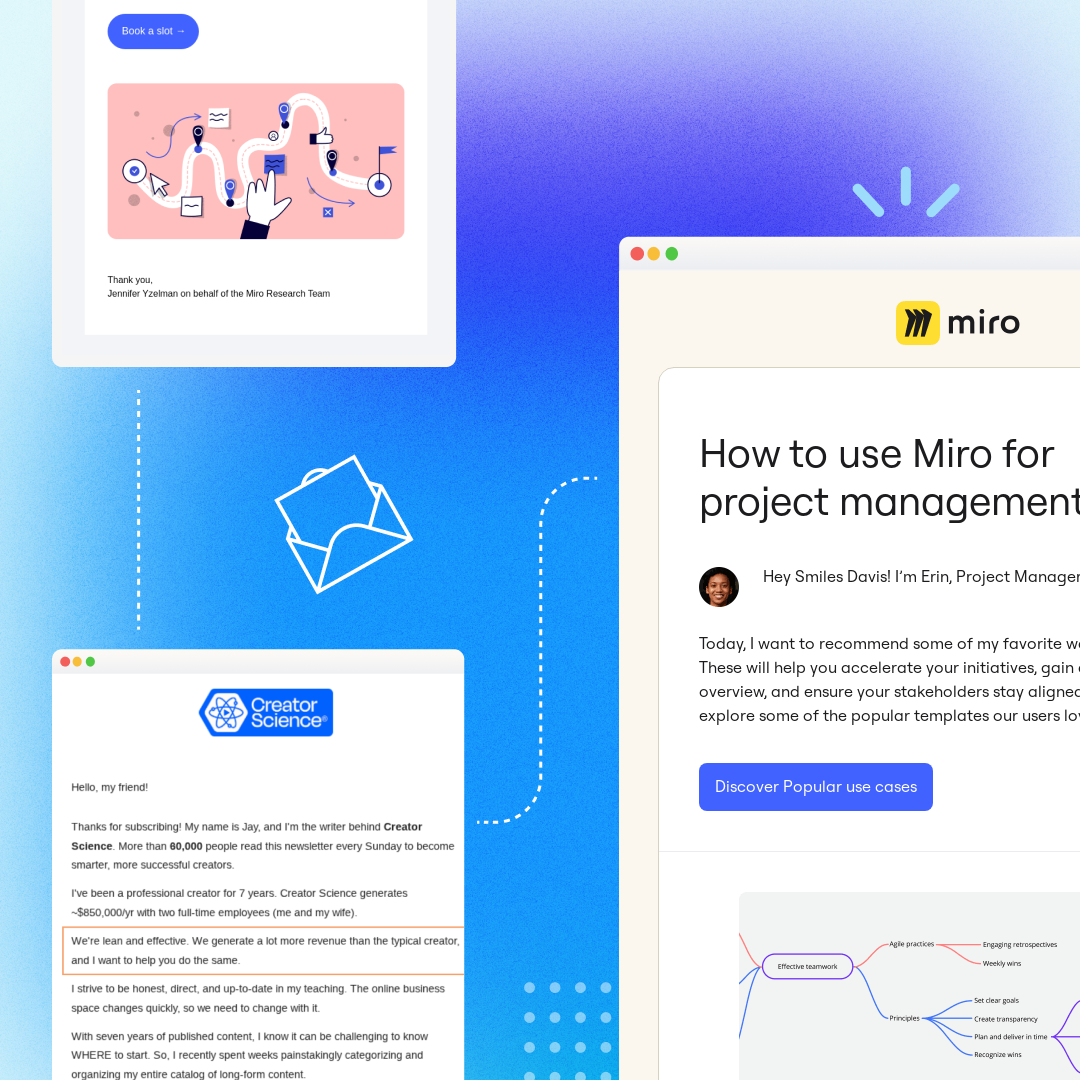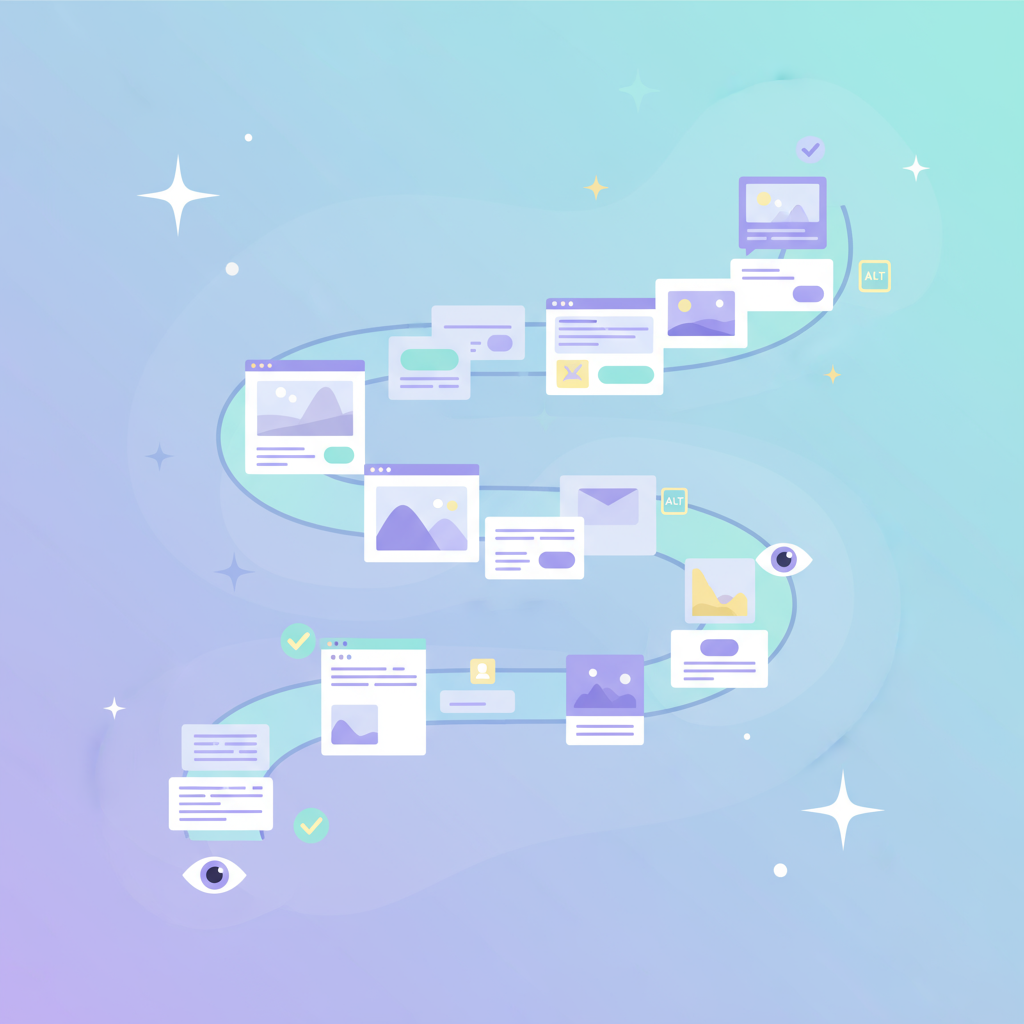
Email marketing automation makes it possible for businesses to send personalized emails at the right time to maximize opens and click-throughs. This marketing process involves triggering specific emails to specific groups or individuals based on the actions they take.
These triggers can range from simple actions, such as sending a thank-you email to a customer after a purchase, to more complex ones, like launching multi-step, audience-segmented campaigns aimed at brand awareness, sales, or lead generation.
How do Automated Emails work?
Understanding how automated marketing emails work involves reviewing the strategic process marketers go through. This process starts with the conception of a marketing tactic and finishes with its implementation.
First, identify a marketing tactic or a goal that is consistent with the company's objectives. These objectives involve anything from increasing brand awareness, customer retention, or overall increasing sales.
Second is the strategy formulation stage. This involves developing a comprehensive strategy that considers various aspects of the target audience, including their demographics, behaviors, preferences, and needs. For example:
- Behavioral data, such as past purchase history or browsing patterns, can help tailor content that resonates with the recipient and, specifically, what they are more likely to be interested in/purchase—inevitably, driving conversions.
- Audience attributes, such as demographics, preferences, and needs, inform the segmentation and personalization of emails, ensuring the message is curated to drive engagement.
- The overall objective, be it brand awareness, customer retention, or sales, helps determine the appropriate tone, content, and call to action for each email, thus aligning the email strategy with broader marketing and business goals.
Understanding these enables marketers to create a targeted and well-planned email campaign that aligns with the overarching marketing strategy.
Email Automation Platforms
Marketers leverage email automation platforms to bring their email campaigns to life.
These platforms are not just tools that facilitate the crafting and sending of emails. They are programmed to make segmenting audiences, creating personalized messages, and scheduling emails at the optimal time based on triggers or conditions easier than ever.
Some popular ones you might have heard of are Mailchimp, HubSpot, and Salesforce.
How to Create an Automated Marketing Email
Creating an automated marketing email doesn't have to be a complex task, especially if you're equipped with the right tools.
For instance, agnostic tools like Beefree simplify the process and integrate seamlessly with existing solutions to make your email creations (and exporting) a whole lot more streamlined.
While email-sending platforms are great at automation, when it comes to design, they can be a little limiting. Beefree helps in that department.
So, how can you create automated marketing emails that keep design and strategy in mind?
Let’s get to it.
Step 1. Determine Your Email Marketing Goals & Target Audience
Before crafting your email, start by establishing the goals of your email marketing campaign. The goal could vary from increasing brand awareness, generating leads, or converting leads into customers. The aim is to set clear, measurable, and timely goals aligning with your business objectives. Think “SMART.”
Equally critical is identifying your target audience. Effective email marketing isn't just about sending emails; it's about sending the right message to the right people.
To do this, you need to understand your customers' behaviors, preferences, and challenges. This understanding enables you to create personalized and impactful email campaigns that deliver results.
Step 2. Craft Compelling Content
Once you've identified your goals and audience, the next step is crafting compelling content.
Your subject line, preview text, and email content need to work in harmony to captivate your audience. Each element plays a crucial role in influencing whether your email gets opened, read, and acted upon.
Be sure to include clear and persuasive call-to-actions (CTAs) to guide your reader on the next steps. Remember, readers typically make decisions on whether to click in a matter of seconds, so these need to be short and impactful!
While content is key, don't underestimate the power of a well-designed email. A visually appealing email enhances the overall user experience, making navigating the content easier for your reader.
Beefree's templates provide the ideal starting point for creating professionally designed emails that look great and resonate with your audience.
Read: The Non-Marketer's Guide to Writing Emails Like a Copywriter
Step 3. Design your automated email
Good design is impactful. It involves creating a visual road map for your audience.
Each design element, from the choice of colors and fonts to the placement of images and CTAs, contributes to the readability and effectiveness of your email. For instance, strategically positioned CTAs can significantly improve click-through rates and drive your desired actions.
The design should also parallel the email content and your brand — a huge sale being offered may warrant bold, bright colors, whilst an update about a new product launch may be in keeping with your traditional brand colors to reinforce brand identity. These are just examples, but it’s something to consider when in the design phase.
Step 4. Set up Automation & Triggers
Once you're satisfied with your email's design and content, it's time to set up automation and triggers. This is what takes your marketing strategy to the next level.
This process involves defining the specific conditions or actions that will trigger your email to be sent. Depending on your marketing goals, these triggers could be based on user behavior, certain dates, or a specified schedule.
By leveraging Email Service Providers (ESPs), these triggers can be easily defined, and the automation process can be more seamlessly set up.
Step 5. Test, Analyze, & Optimize
Testing is critical to effective automated email creation. It involves sending out test emails to validate the proper functionality of all email elements.
This means checking if the layout appears correctly across different devices and browsers, ensuring links and CTAs are functioning as intended, and verifying the deliverability of your email.
One widely used method of testing is A/B testing, or split testing. It is a data-driven strategy that compares two versions of an email to determine which one performs better.
The process involves changing one element in an email variant, such as the subject line, CTA, or images, and sending the two versions to similar audience segments. The version that generates a higher open rate, click-through rate, or conversion rate is deemed the more effective one.
This method provides valuable insights into what resonates most with your audience and allows for continuous improvement of your email strategy.
Once your email campaign is live, monitoring its performance is key to understanding its effectiveness. This is done through a thorough analysis of key metrics like open rates (the percentage of recipients who open your email), click-through rates (the percentage of recipients who click a link within your email), and conversion rates (the percentage of recipients who perform a desired action, like making a purchase or filling out a form).
These metrics provide a quantitative measure of your campaign's success and reveal areas that may require improvement.
With these insights, you can optimize your email campaigns to better align with your audience's needs and preferences. This could involve making changes to the email content, design, delivery timing, or even your audience segmentation.
The Benefits of Email Marketing Automation
Email marketing automation brings numerous benefits to businesses of all sizes and types.
At its core, it's about streamlining and maximizing the effectiveness of your email marketing efforts. Automated emails allow businesses to nurture leads, increase customer retention, and drive more sales without the need for huge amounts of manual intervention.
Three more benefits include:
- Timely, personalized communication: Automated emails can be set up to trigger based on specific behaviors or events, such as welcoming a new subscriber, acknowledging a customer's purchase, or re-engaging a dormant customer. This enables businesses to reach customers with the right message at the right time, enhancing customer experience and boosting engagement rates.
- Scalability: As your business grows, it becomes challenging to maintain consistent, personalized communication with a growing customer base. Email marketing automation reduces this hurdle, enabling you to scale your marketing efforts without compromising on quality or personalization.
- Insights: Email marketing automation provides valuable insights into customer behavior and campaign performance. By analyzing key metrics such as open rates, click-through rates, and conversion rates, you can understand what resonates with your audience and continually refine your approach for better results.
How to Get Started with Email Marketing Automation
Email marketing automation involves setting clear goals, understanding your audience, crafting compelling content and a visually appealing email design, and setting up automation and triggers. Don't forget to continually test, analyze, and optimize your emails to achieve better results.
Choosing the right email delivery platform is key to effective email marketing automation. Whether you're just starting out or looking to enhance your existing process, an agnostic email builder likeBeefree, which can easily integrate with your sending platform, can help simplify and enhance your email marketing efforts. The best part? It's free. Sign up now!



